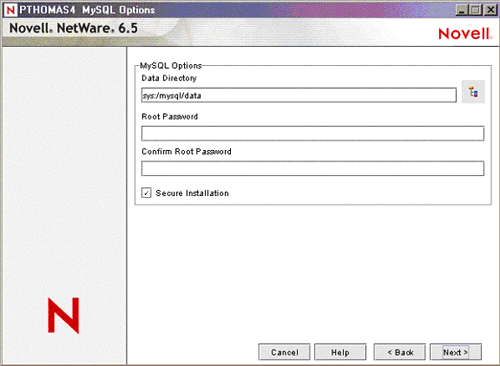2.2 Installing MySQL
During the NetWare 6.5 installation process, you can customize your server by selecting individual components to be installed, or you can select a specific server type from a list of fifteen pre-configured servers, which installs the necessary software needed to support a specific server solution.
For example, if you wanted to dedicate a NetWare server to hosting database-driven Web applications, you could select the NetWare AMP (Apache, MySQL, PHP, Perl) Server from the Pre-Configured Servers list. Or, if you simply needed to build and host a database, you could select MySQL from the Components dialog box when you choose the Custom NetWare Server option.
The following table can help you decide which installation option you should choose based on how you want to use MySQL on NetWare 6.5.
After you have decided which installation option to use, see the NW65 SP8: Installation Guide for detailed installation instructions.
For important legal issues related to your use of MySQL 4.0, refer to the sys:\mysql\license.doc file after installation.
For information about removing MySQL from your server, see Section 2.8, Uninstalling MySQL.
2.2.1 Information Required During Installation
Regardless of the method you choose, you are asked to specify the following information:
-
Data Directory: The MySQL data directory is where MySQL databases are stored. The directory must reside on an NSS volume. The default location is sys:\mysql\data. The MySQL install sets this path as the value of the datadir property in the [mysqld] section of sys:\etc\my.cnf.
-
Root Password: The MySQL root user is created as a superuser who has access rights to perform any function.

Secure Installation
By default, the Secure Installation check box is checked. Therefore, the MySQL install requires a root password before proceeding. This creates and configures the initial MySQL database and ensures the following:
-
The initial MySQL database is created and configured so that only the root user is allowed to connect to it, and only from the local host.
-
The anonymous user and the test database are not created.
IMPORTANT:For production servers, we recommend that you leave Secure Installation checked so that the remote and anonymous users and test databases are not created.
Security Problems that Occur When Secure Installation is not enabled:
-
The root user can connect from the local host or remotely.
-
An anonymous user is also created and can connect from the local host or remotely.
-
By default, an initial test database is created. This means that any local user can connect without a password and be treated as the anonymous user.
-
The anonymous user can perform any function on any databases named "test" or whose name begins with "test_."
2.2.2 Installing As Part of NetWare AMP
When you select the NetWare AMP pre-configured server option, the following changes are made to the sys:\etc\my.cnf file to optimize the performance of MySQL on NetWare 6.5:
If server memory >= 500 MB:
key_buffer_size = 128M
table_cache = 128
sort_buffer_size = 4M
myisam_sort_buffer_size = 32M
read_buffer_size = 1M
If server memory >= 1 GB:
key_buffer_size = 256M
table_cache = 256
sort_buffer_size = 8M
myisam_sort_buffer_size = 64M
read_buffer_size = 2M
In addition, the namp_config_on.ncf file is run which makes the following server setting changes:
SET TCP Minshall Algorithm = ON
SET Maximum Pending TCP Connection Requests = 4096
You can run namp_config_off.ncf to manually reset these settings:
SET TCP Minshall Algorithm = OFF
SET Maximum Pending TCP Connection Requests = 128
Startx, the command that starts the NetWare GUI, is not included in the autoexec.ncf. Leaving it out of the autoexec.ncf prevents the NetWare GUI from starting up automatically whenever the server is restarted, which makes additional system resources available for use by MySQL.